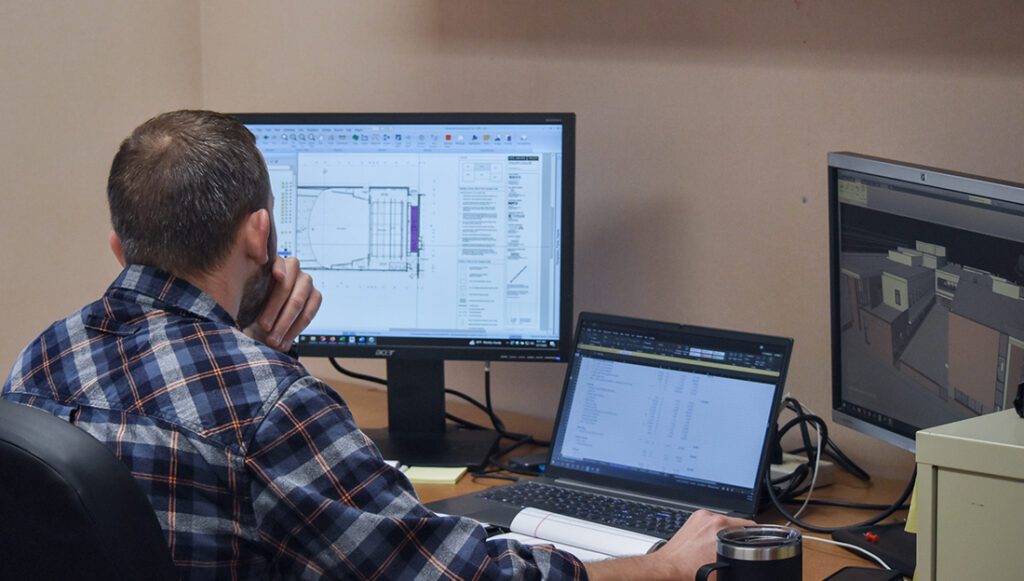Preconstruction and Why it Matters to You
January 6, 2023
The Intangible Value of Preconstruction, Why it Matters to You
The preconstruction process is one of the most misunderstood services we provide to our clients as a construction manager, but also the most critical for the project’s success.
It takes months, potentially up to a year to design a large commercial building. This process involves hundreds of decisions, meetings, and input from a variety of stakeholders. As a construction manager, we collaborate closely with the design team through each phase of design.
Discussion with Frank, Director of Preconstruction at Hammond for over 25 Years.
We sat down with Hammond’s Director
of Preconstruction, Frank Mongiardo, to walk us through the phases of preconstruction. Frank has been with Hammond for over 25 years providing estimating and preconstruction services for our clients. He has witnessed significant changes in the construction market during his tenure, providing him with invaluable expertise and long-standing relationships with subcontractors and suppliers across the region.
What does the term “preconstruction” mean?
The term “preconstruction” generally signifies the time between the start of design up until the start of construction. There are three key phases in this process – Schematic Design (SD), Design Development (DD) and Construction Documents (CD). As construction manager, our primary role during preconstruction is to provide estimates, value engineering, constructability reviews, logistics planning and a project schedule.
The first phase, Schematic Design, includes developing floor plans, exterior elevations, major structural components, and types of mechanical and electrical system to be used in the building. The civil component, or site layout, is well defined. The location of the building, proposed finish floor elevation, grading work, parking lot locations and many of the utilities are shown. This initial phase of design is critical, as it establishes the overall plan for the project. “Pricing-wise, it is the most important estimate we provide to the Owner, it sets the Benchmark or Baseline” says Frank. At this point we can still make changes before the design gets too far along whether the challenges are constructability or budgetary constraints.
What are the struggles in today’s market?
In today’s market our clients are facing unprecedented challenges with funding and budget compliance. Today’s dollars don’t buy what their initial master plan established just a few years prior. Owners are having to make really difficult decisions early on, determining what parts of their programs or building to reduce so the project can stay on budget. “It has become so important in today’s market to guide the Owners, to help them develop solutions or make decisions to best spend their money,” says Frank.
Generally, at the conclusion of schematic design, we have established the logistics, phasing plans and project schedule. The design team will move forward to the next stage, Design Development (DD). During DD, the team is developing more detail on the building components. This includes a preliminary spec book, building elevations and building sections. At this time the Mechanical and Electrical consultants are heavily engaged. The floor plans show more detail including interior elevations, casework and major equipment locations and sizing. Our team continues to refine the plan for phasing and logistics, and our estimate becomes more accurate due to the additional details.
The final stage of preconstruction.
The final stage of developing the design is creating the Construction Documents (CD). This stage is about finalizing the details needed in the drawings to send the project out to bid. For the construction manager, a significant amount of time in this phase is working towards a GMP or Guaranteed Maximum Price. We typically take the documents somewhere around 75% complete to create the GMP Amendment. This guaranteed cost is an important component of the CMR delivery method, as it protects the owner from the risk of cost/bid overages. If you had to simplify the goals of the GMP, Frank explains it as “the overall plan, schedule, logistics and cost that everyone at the table is comfortable with”.
“Transparency and communication are the keys to making sound decisions.”
-Frank Mongiardo
Throughout the preconstruction process, Hammond’s strategy is to report as much information as we can to the Owner. Transparency and communication are the keys to making sound decisions. This is where the true value of the construction manager reveals itself. There is an intangible val
ue a CMR provides with cost-effective solutions, bid strategies, logistics planning and expertise as a construction professional. Combined, these resources help our clients to make the best decisions possible, maximizing the dollars available and constructing a quality facility for their community.
What can we expect to see in the future?
Looking ahead, we are all seeking indications of change. This market has been challenging and at times demoralizing to building programs across the nation. When asking Frank what he sees for 2023, he says, “I’m optimistic that project budgets will become more attainable, but I don’t believe the market has settled quite yet”.


